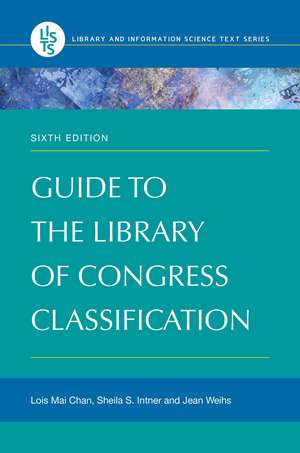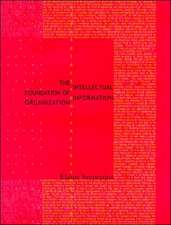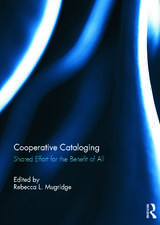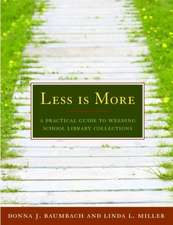Guide to the Library of Congress Classification: Library and Information Science Text Series
Autor Lois Mai Chan, Sheila S. Intner, Jean Weihsen Limba Engleză Paperback – 25 sep 2016 – vârsta până la 17 ani
Din seria Library and Information Science Text Series
- 26%
 Preț: 346.94 lei
Preț: 346.94 lei - 17%
 Preț: 397.13 lei
Preț: 397.13 lei - 34%
 Preț: 368.61 lei
Preț: 368.61 lei - 26%
 Preț: 402.54 lei
Preț: 402.54 lei - 32%
 Preț: 355.47 lei
Preț: 355.47 lei - 18%
 Preț: 353.91 lei
Preț: 353.91 lei - 27%
 Preț: 345.08 lei
Preț: 345.08 lei - 23%
 Preț: 338.93 lei
Preț: 338.93 lei - 11%
 Preț: 352.01 lei
Preț: 352.01 lei - 26%
 Preț: 355.06 lei
Preț: 355.06 lei - 26%
 Preț: 356.01 lei
Preț: 356.01 lei - 18%
 Preț: 334.67 lei
Preț: 334.67 lei - 23%
 Preț: 338.52 lei
Preț: 338.52 lei - 26%
 Preț: 353.80 lei
Preț: 353.80 lei - 21%
 Preț: 413.93 lei
Preț: 413.93 lei - 17%
 Preț: 325.46 lei
Preț: 325.46 lei - 30%
 Preț: 262.32 lei
Preț: 262.32 lei - 17%
 Preț: 268.94 lei
Preț: 268.94 lei - 27%
 Preț: 384.89 lei
Preț: 384.89 lei - 13%
 Preț: 360.73 lei
Preț: 360.73 lei - 22%
 Preț: 398.74 lei
Preț: 398.74 lei - 23%
 Preț: 379.25 lei
Preț: 379.25 lei - 13%
 Preț: 362.63 lei
Preț: 362.63 lei - 13%
 Preț: 361.22 lei
Preț: 361.22 lei - 17%
 Preț: 308.11 lei
Preț: 308.11 lei - 23%
 Preț: 392.82 lei
Preț: 392.82 lei - 12%
 Preț: 363.38 lei
Preț: 363.38 lei - 22%
 Preț: 351.17 lei
Preț: 351.17 lei - 23%
 Preț: 344.93 lei
Preț: 344.93 lei - 18%
 Preț: 358.30 lei
Preț: 358.30 lei - 30%
 Preț: 263.78 lei
Preț: 263.78 lei - 12%
 Preț: 369.76 lei
Preț: 369.76 lei - 26%
 Preț: 358.85 lei
Preț: 358.85 lei - 26%
 Preț: 348.21 lei
Preț: 348.21 lei
Preț: 395.77 lei
Preț vechi: 510.80 lei
-23% Nou
Puncte Express: 594
Preț estimativ în valută:
75.74€ • 82.24$ • 63.62£
75.74€ • 82.24$ • 63.62£
Carte tipărită la comandă
Livrare economică 22 aprilie-06 mai
Preluare comenzi: 021 569.72.76
Specificații
ISBN-13: 9781440844331
ISBN-10: 144084433X
Pagini: 392
Dimensiuni: 178 x 254 x 25 mm
Greutate: 0.86 kg
Ediția:Revised
Editura: Bloomsbury Publishing
Colecția Libraries Unlimited
Seria Library and Information Science Text Series
Locul publicării:New York, United States
ISBN-10: 144084433X
Pagini: 392
Dimensiuni: 178 x 254 x 25 mm
Greutate: 0.86 kg
Ediția:Revised
Editura: Bloomsbury Publishing
Colecția Libraries Unlimited
Seria Library and Information Science Text Series
Locul publicării:New York, United States
Caracteristici
Serves primarily as an introductory textbook for core LIS courses in cataloging and classification and in organization of information but also as a reference work for practicing librarians
Notă biografică
Lois Mai Chan was professor, College of Library and Information Science, University of Kentucky, Lexington. Sheila S. Intner is professor emerita of library and information science at Simmons University, Boston, MA, and was founding director of its MLIS program at Mount Holyoke College, South Hadley, MA.Jean Weihs was director of the library techniques program at Seneca College of Applied Arts and Technology, Toronto, Canada, until her retirement.
Cuprins
Preface1-IntroductionOverviewEarly Development of the Library of Congress ClassificationEarliest SystemsThomas Jefferson's SystemThe New Library of Congress ClassificationThe Outlines of the New ClassificationThe Development of Individual SchedulesThe Focus of the Library of Congress ClassificationLiterary WarrantSummaryNotes2-Principles, Structure, and FormatOutline of the ClassificationNotationEnumerative DisplayGeneral Characteristics and Common FeaturesPhysical FormatIndividual Schedules,Format of Schedules,DivisionsGeneral Form Divisions,Philosophy,History,Biography,General Works,Study and Teaching,Topics and Subdivisions of Topics,Geographic Division,Topical Division under Country,Example of Subdivisions,Notes in Classification SchedulesScope Notes,Confer Notes,See Reference,"For . . see . . ." Reference,Including Notes,Parenthesized NumbersAlternate Class NumbersSupplementary Aids to the Use of the ClassificationGeneral Index to the SchedulesManuals for the ClassificationOther Aids to Using the ClassificationProcedures for Revision and ExpansionMethods for ExpansionSummaryNotes3-NotationGeneral Features of the NotationCall NumbersClassification NumbersItem NumbersConstructing Call NumbersLibrary of Congress Cutter NumbersCutter TableSingle Cutter NumberDouble Cutter NumbersClass Number Extension: Item Number,Class Number Extension: Further Subdivision of SubjectTopical Cutter NumbersCutter Numbers as Geographic Subdivisions"A" and "Z" Cutter NumbersDates in LC Call NumbersDates as Part of Class NumbersDate of Imprint as Part of Class Number,Date of Period, Policy, etc., as Part of Class Number,Dates of PublicationSelecting the Appropriate Date,Distinguishing Works by an AuthorDistinguishing Editions of a WorkTranslationsDisplay of the NotationMARC Codes for LC Call Numbers in Bibliographic RecordsAuthority Records for LC Classification NumbersSummaryNotes4-TablesIntroductionTables of General ApplicationGeographic Division in Alphabetical ArrangementRegions and Countries Table,Subarrangement,Table for U.S. States and Canadian Provinces,Name Changes,Biography TableTranslation TableTables of Limited ApplicationTables for Internal SubarrangementTables for Internal Subarrangement Appearing withinSchedules,Tables for Internal Subarrangement Appearing at the End of Schedules,Tables Applicable to an Individual Class or Subclass,SummaryNotes5-Assigning Class NumbersIntroductionGeneral PolicyWorks on a Single TopicWorks on a Single Topic with Respect to One or More FacetsGeneral Works,General Special,Form,Place,Period,Multifaceted Works,Multi-Topic WorksWorks on Four or More Topics,Phase Relations,Special ConsiderationsClassifying Different Editions of the Same WorkCity Regions and Metropolitan AreasTextbooksSchool TextbooksSummaryNotes6-Individual ClassesIntroductionClass A-General WorksOutlineWorks about MuseumsWorks by and about Academies and Learned SocietiesTables Used with Society Publications,YearbooksTables in Subclass AY,History of Scholarship and LearningTables in Subclass AZ,Class B-Philosophy. Psychology. ReligionOutlineSubclasses B-BJSubclasses BL-BQSubclasses BR-BXClass C-Auxiliary Sciences of HistoryOutlineClass D-History (General) and History of EuropeOutlineSubclasses D-DRSubclasses DJK-DKSubclasses DL-DRSubclasses DS-DXClass E-F-History: AmericaOutlineClass E-United StatesClass F-United States Local History, British America, DutchAmerica, French America, Latin America, Spanish AmericaClass G-Geography. Maps. Anthropology. RecreationOutlineGeographic CuttersTables for Maps and AtlasesSpecial Instructions and Tables of Subdivisions forCartographic MaterialsMajor Areas,Sub-Areas,Subject Subdivisions,Examples of Call Numbers of Maps and AtlasesGeneral Maps and Atlases,Subject Maps and Atlases,Series of Maps,Other Auxiliary Tables in Class GClass H-Social SciencesOutlineSubclassesInternal TablesAuxiliary TablesTables of Geographical Divisions,Tables of Subdivisions under Regions or Countries,Tables of Subdivisions ofIndustries and Trades,Class J-Political ScienceOutlineSubclassesTablesClass K-LawOutlineSubclass KSubclass KBSubclass KDSubclasses KDZ, KG-KHSubclass KESubclass KFSubclasses KJ-KKZSubclasses KL-KWXSubclass KZRevised Form Division Tables in Class K,Examples of Classification of LawClass L-EducationOutlineTables in Class LTextbooksWorks on Teaching Methods in Special SubjectsClass M-MusicOutlineCutter NumbersInstrumental MusicCollections,Selections,Arrangements,Vocal MusicWorks about MusicDiscographyClass N-Fine ArtsOutlineOrder of PrecedenceTablesArtistsClass P-Language and LiteratureOutlineClassification of LiteraturePattern of Subarrangement,Literary Collections,Individual Authors,P-PZ Tables: Language and Literature TablesSubclasses P-PATopical Greek and Roman Classics,Subclasses PB-PHSubclass PGSubclasses PJ-PK, PL-PMSubclass PNSubclasses PR, PS, PZAuxiliary Tables in PR, PS, PZ,Subclass PQSubclass PTSubclass PZP-PZ TablesAuthor TablesCall Numbers in Languages and LiteratureClass Q-ScienceOutlineTablesBook NumbersClass R-MedicineOutlineNational Library of Medicine ClassificationClass S-AgricultureOutlineHunting and FishingAdditional ExamplesClass T-TechnologyOutlineAuxiliary TablesClasses U-V-Military Science. Naval ScienceClass U-Military ScienceOutlineClass V-Naval ScienceOutlineClass Z-Bibliography. Library Science. InformationResourcesOutlineTablesBook Industries and Trade and Libraries and LibraryScienceNational BibliographySubclass ZALibrary of Congress PublicationsNotesBiographyCollective BiographyIndividual BiographyBiography Classed in Biography Numbers,BiographyClassed in "General"Numbers,Special CasesWorks about Rulers and Chiefs of State,Works about Statesmen, Public Figures, etc.,Serial PublicationsSpecial Form Numbers for Serials"A" Cutter Numbers for Periodicals or Serial Publications"General Works" Numbers Used for PeriodicalsYearbooksMonographic SeriesSubseriesSerial ContinuationsNonserial Collections, Collected Sets, and Collected WorksNonserial Collections or Collected WorksSelected WorksAnalysis of Monographic Series and SetsMaterials Cataloged under Corporate HeadingsClassificationShelflisting ProceduresMonographs,Works about Corporate Bodies,Commentaries and Supplements,Indexes,Serials,Changes of Name,Materials from Special SourcesSociety PublicationsGovernment Publications Classed in Documents NumbersMonographs,Corporate Entries,Congressional and State Legislative Hearings and ReportsConferences, Congresses, etcShelflisting Conferences, Congresses, etcWorks Related to Other WorksEditionsTranslationsParallel TextsAbridgementsAdaptationsCommentaries on Individual WorksSupplementary WorksSupplements Cataloged Separately,Supplements Covered by a Statement in the Physical Description Area or a Note,IndexesWorks Requiring Special TreatmentAbstracts and Annotated BibliographiesIncunabula"Bound-With"BooksComic Books and Graphic NovelsAudiovisual Media and Their CatalogsDiscographies,Catalogs of Films,MicroformsComputer Files and Software"Juvenile"ResourcesJuvenile Belles LettresPicture Books for ChildrenTopical Juvenile ResourcesSchool TextbooksNotes8-The Future of the LC ClassificationLibrary ComputingBenefits of Continuing to Use the LC ClassificationFuture PossibilitiesSuggestions for Additional ReadingNotesAppendix A: General TablesCutter TableRegions and Countries TableUnited StatesCanadian ProvincesBiography TablePreferred Shelflist Order - Individual AuthorsTranslation TableMusic Translation TableAppendix B: Models for Subarrangement within DisciplinesModel for the D SchedulePart 1-General,Part 2-Major Periods or Centuries,Part 3-Major Cities,Model for the H ScheduleModel for the Q ScheduleModel for the R ScheduleGlossaryBibliographyIndex
Recenzii
Universities offering a program in library science will certainly want to have this volume, but other academic institutions may well want to add a copy for their library staff.
The Guide to the Library of Congress Classification is a clear and comprehensive treatment of the history, principles, structure, and use of the Library of Congress classification scheme. . . . Catalogers and cataloging supervisors who have relied on Immroth's and Chan's guides in the past will undoubtedly welcome the new edition designed for our times. Veterans and novices alike will find it an indispensable tool both for training and reference for years to come.
The Guide to the Library of Congress Classification is a clear and comprehensive treatment of the history, principles, structure, and use of the Library of Congress classification scheme. . . . Catalogers and cataloging supervisors who have relied on Immroth's and Chan's guides in the past will undoubtedly welcome the new edition designed for our times. Veterans and novices alike will find it an indispensable tool both for training and reference for years to come.







